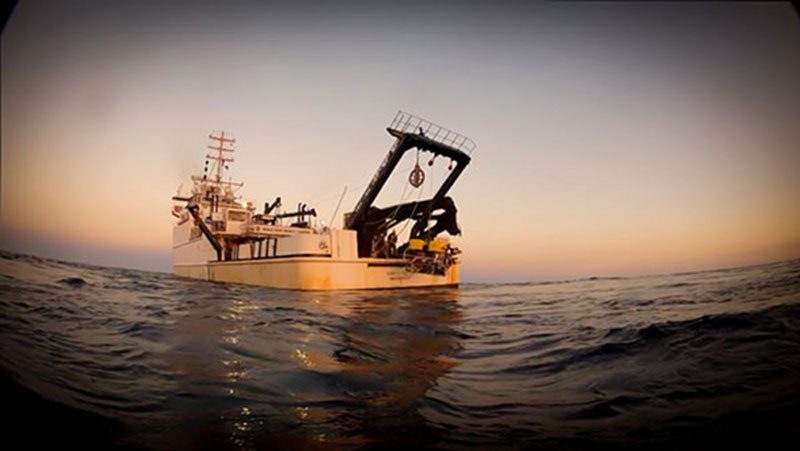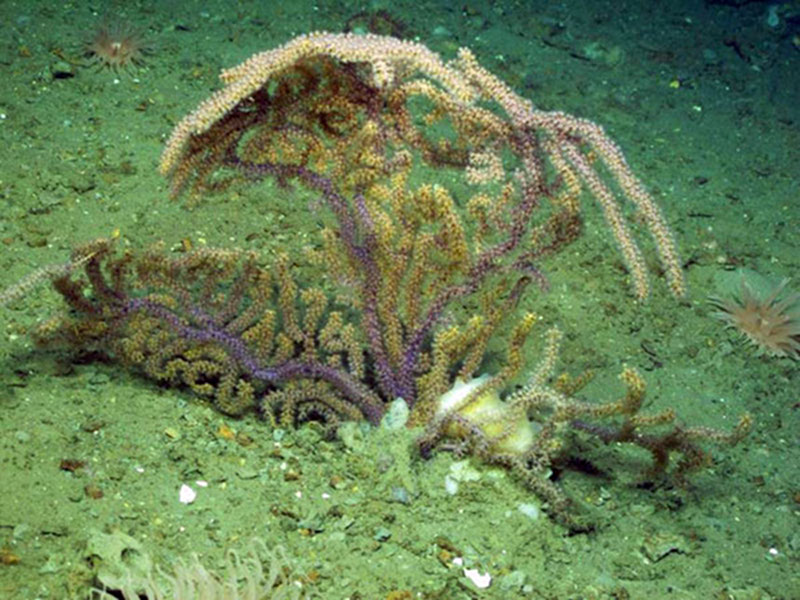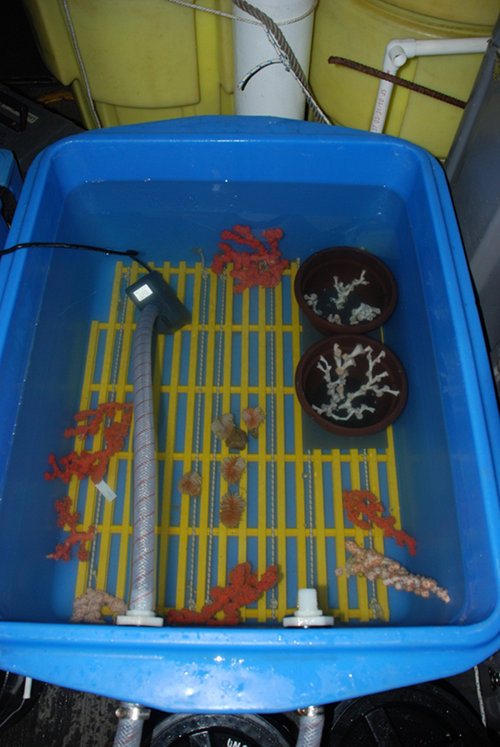
By
Steve W. Ross - UNC-W, Center for Marine Science
Sandra Brooke - Marine Conservation Institute/OIMB
September 12, 2012

NOAA ship Nancy Foster retrieving the ROV Kraken II at sunset on 12 Sep 2012 Image courtesy of A. Howard, Deepwater Canyons 2012 Expedition, NOAA-OER/BOEM. Download image (jpg, 51 KB).
Today is our last dive in Baltimore Canyon and the next to last dive of this cruise leg. We’re off to Norfolk Canyon to end the cruise after today’s dive and one more trawl sample. This morning was a perfect start – calm seas, clear skies, an ROV launch on time and the ship surrounded by pilot whales. We hit the bottom at 600 m and are heading toward a place to collect a particular type of coral (Paramuricia) for one of our team, mapping habitats and noting/collecting organisms along the way. In all of our dives so far we have only seen this coral in this one area. If we have time, we will also look for our benthic lander at the end of the dive.

A colony of Paramuricea on a ledge of Baltimore Canyon. This coral was only seen in a small area of the canyon. Image courtesy of Deepwater Canyons 2012 Expedition, NOAA-OER/BOEM. Download image (jpg, 141 KB).
While this cruise leg has been challenging, it has also been productive. We have had delays and lost stations caused by bad weather (a hurricane that would not make up its “mind“), an outbreak of virus that made several people sick, and issues with our new winch, but throughout this, the science and ship crew worked diligently to make the best of our time. Reflecting back on the two cruise legs so far, as of today we have made 19 ROV dives and over 150 ship based stations. We have been very successful in discovering and documenting new areas of hard ground and coral habitat, a cold (methane) seep (one of only three known on the US east coast), and the last two days we encountered the giant solitary coral, Desmophyllum dianthus, which is important to several of our science objectives. Fish communities have been diverse and many fishes seem to have close ties to the rugged bottom habitats. At the start of this leg, we deployed our last two landers, one in the head and one in the mouth of Baltimore Canyon. The shallower lander (620 m) contained three chambers holding living colonies of bubblegum coral which we hope will provide data on growth and survival when we retrieve them next year. Trash and lost fishing gear were commonly observed on the bottom, evidence of intense human usage of these areas. In relation to that we have seen a number of commercially important species on the bottom, including red crabs, cusk, other hakes, and lobster.

Insulated tank of seawater holding live corals collected in Baltimore Canyon. We use a chiller and clean seawater. It’s a lot of work but produces the unique ability to conduct various experiments. Image courtesy of SW Ross, Deepwater Canyons 2012 Expedition, NOAA-OER/BOEM. Download image (jpg, 101 KB).
The data collected this year will be critical in planning future missions and will make our cruise next year much more productive. We are already thinking about next year and have started lists of issues to consider.

Pilot whales surround the Nancy Foster on almost every day, especially when the weather is calm. Image courtesy of S. France, Deepwater Canyons 2012 Expedition, NOAA-OER/BOEM. Download image (jpg, 91 KB).